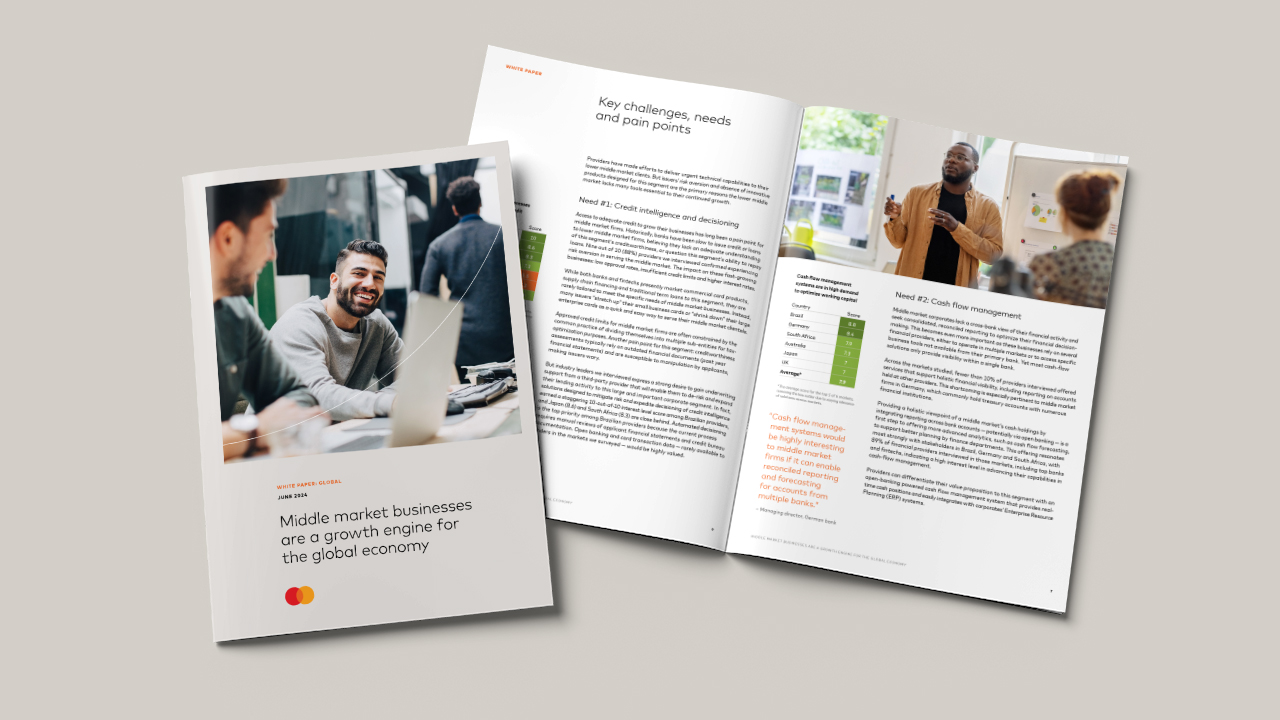The missing middle: The financial tools and services midsize companies need to grow
July 8, 2024 | By Jane Prokop and Marie Aloisi
From software development companies to beauty product makers to regional restaurant chains, middle-market businesses — those with 50 to 250 employees — increasingly fuel global growth. In fact, companies in this sector, while lean, with executives often wearing multiple hats, annually spends $24.2 trillion worldwide, according to Kaiser Associates.
And yet many of these firms are now operating at a major disadvantage. They do not have the tools that could enable them to digitize, automate and streamline their financial and operational processes — key ingredients to success in today’s economic landscape.
A recent Mastercard survey of middle-market businesses in the U.S found there’s a substantial gap between what these firms need and the financial tools to get them there. We then went on to survey banks and fintechs servicing middle market firms in Brazil, South Africa, the U.K., Germany, Japan and Australia, all of which confirmed that the insights found in the U.S. are just as relevant to the mid-market sector in their countries.
The new research underscores an untapped opportunity for the financial community to address the unmet needs of what we are calling the missing middle.
According to the study, one of the most significant challenges middle-market businesses face today is an inability to quickly and seamlessly access adequate credit. This has long been a pain point for small business owners, but the same holds true for businesses that occupy the middle market — in fact they require more cash to innovate and grow but end up facing low approval rates, insufficient credit limits and higher interest rates than large corporations do.
Part of the problem is that would-be lenders lack an adequate understanding of these businesses’ creditworthiness — assessments often rely on outdated financial information because they don’t have access to real-time data — and their ability to repay loans. Lenders rarely tailor their products, such as commercial card products, supply chain financing or traditional loans, to middle-market companies. Instead they focus on the largest companies or small businesses — nothing in between.
A second key problem is cash flow management. Many of these companies typically maintain relationships with several financial providers, piecing together needed products and tools, so they lack a holistic, cross-bank view of their financial activity and health. Most existing cash-flow solutions they have access to today only provide visibility within a single bank.
To satisfy middle-market companies’ growing credit needs, there is a greater demand for new and better credit intelligence and decisioning tools.
For example, consumers and small businesses have been benefiting from open banking-powered solutions for years, which allows them to proactively share their financial account data for more innovative experiences, such as the ability to consolidate their accounts to get a picture of their finances. Building these types of solutions for middle-market companies could help them integrate reporting across accounts. And an open banking-powered cash flow management solution could reassure lenders of firms’ creditworthiness and speed up the lending process.
On the cash flow management side, middle-market companies would also benefit greatly from automated invoicing and collection processes. That’s because, as firms grow, they struggle to sustain the same manual processes they used when they were smaller. They need to get paid faster, because experiencing payment delays threatens to shrink working capital.
Invoice automation is a solid first step. But in order to also streamline the receivables process, middle-market firms will need better buyer communications tools like automated reconciliation and three-way matching — the ability to match purchase order, supplier’s invoice and delivery receipt before payment is made.
Middle-market firms could benefit from solutions like virtual cards, which are temporary card numbers linked to a funding account with an established line of credit that can be integrated into accounting and expense management systems. They come with the ability to set controls over spending — by merchant category, time period or price, for example — and result in faster payments, loosening up cash flow.
Finally, in a world rife with cybercrime and a proliferation of bad actors looking to exploit security gaps, robust cybersecurity is crucial as digitization of operations is now considered business as usual. Many middle-market firms have yet to upgrade their systems as they’ve expanded, leaving them vulnerable to massive disruptions in their business operations.
Pressing as all these needs are today, they’ll only continue to grow more urgent as more small businesses gain greater market share and revenue to qualify as middle market; and as more companies are launched in the middle market space with venture capital and private equity backing.
Increasingly, these firms will look to their banks and fintechs to proactively support them, partly by providing the innovative tools necessary to flourish. Indeed, Mastercard’s survey shows that lower middle-market companies are so hungry for these resources that four out of ten would switch issuers if offered products with a better fit.
Nearly 72% of midsize businesses are considered lower middle-market firms. These are companies that have grown beyond the needs of small businesses and are actively looking to upgrade from their more rudimentary small business solutions.
All of this presents a major opportunity for financial institutions. By offering a blend of solutions that address midsize firms’ many unmet needs — and hitting the Goldilocks balance of neither too big and sophisticated nor too small and overly simplistic — banks and fintechs can establish themselves as true partners to the middle market. And then they can watch this promising sector grow.
Jane Prokop is executive vice president and global head of small and medium enterprises at Mastercard. Marie Aloisi is executive vice president for U.S. commercial payments, acceptance, health care and merchant verticals.

White paper
Middle market businesses are a growth engine for the global economy
To understand how we can better meet the needs of middle market businesses globally, Mastercard commissioned research to identify the priorities, pain points and unmet needs of this fast-growing and underserved segment.
Read more